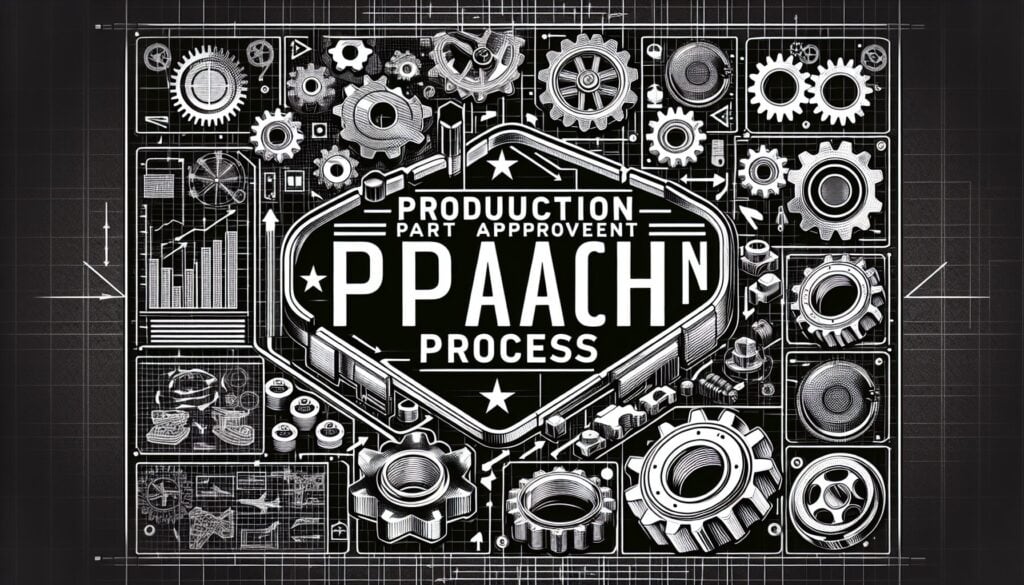Ein standardisiertes Verfahren in der Automobil-, Luft- und Raumfahrtindustrie (und anderen Branchen), das sicherstellt, dass die Zulieferer durchgängig Teile herstellen können, die den technischen Konstruktionsunterlagen und Spezifikationen des Kunden entsprechen.
- Methodologien: Kunden & Marketing, Ideenfindung, Produktdesign
PPAP (Produktionsteil-Freigabeverfahren)

PPAP (Produktionsteil-Freigabeverfahren)
- Erweiterte Produktqualitätsplanung (APQP), Prozess-Fähigkeit, Prozessverbesserung, Produktionsteil-Genehmigungsprozess (PPAP), Qualitätssicherung, Qualitätskontrolle, Qualitätsmanagement, Qualitätsmanagementsystem (QMS), Macht der Lieferanten
Zielsetzung:
Wie es verwendet wird:
- Der Zulieferer stellt ein Paket von Dokumenten und Mustern (das PPAP-Paket) zusammen, mit dem er nachweist, dass sein Fertigungsverfahren durchgängig Teile herstellen kann, die alle Anforderungen erfüllen. Dieses Paket wird dem Kunden zur Genehmigung vorgelegt, bevor die vollständige Produktion beginnt.
Vorteile
- Gewährleistet eine klare Kommunikation der Anforderungen zwischen Kunde und Lieferant; Überprüft das Verständnis des Lieferanten und seine Fähigkeit, die Anforderungen zu erfüllen; Reduziert das Risiko von nicht konformen Teilen in der Produktion; Liefert einen objektiven Nachweis für Prozessfähigkeit.
Nachteile
- Die Anforderungen können komplex sein und von Kunde zu Kunde variieren; Änderungen an Produkten oder Prozessen erfordern oft eine erneute Vorlage, was die Arbeitsbelastung erhöht.
Kategorien:
- Herstellung, Qualität
Am besten geeignet für:
- Sicherstellung, dass die Produktionsprozesse der Zulieferer in der Lage sind, vor der Massenproduktion durchgängig Teile zu produzieren, die allen Kundenspezifikationen entsprechen.
PPAP is widely utilized in automotive, aerospace, and manufacturing industries, where the precise quality of parts is paramount. This methodology is particularly relevant during the transition from prototype to mass production, ensuring that any parts submitted can meet the design specifications and regulatory standards expected by the customer. Participants typically include suppliers, quality assurance teams, and engineering personnel from both the supplier and customer sides, creating a collaborative environment for clarity and mutual understanding. Key components of the PPAP package may include design records, engineering change documents, process flow diagrams, control plans, measurement systems analysis, and initial sample inspection reports. These documents serve to verify that all production processes are capable of producing conforming product consistently, offering a systematic approach to quality management. Engaging in this process can preemptively address potential discrepancies, thus minimizing the likelihood of costly production delays or recalls caused by non-conforming products. The adoption of PPAP enhances transparency and trust, as both suppliers and customers are committed to fulfilling agreed-upon quality benchmarks, fostering a strong partnership built on accountability and shared objectives in delivering quality outcomes.
Die wichtigsten Schritte dieser Methodik
- Review customer specifications and requirements.
- Conduct a process flow diagram analysis.
- Complete the Process Failure Mode and Effects Analysis (PFMEA).
- Establish control plans for the manufacturing process.
- Perform measurement system analysis (MSA).
- Validate product design through dimensional and functional testing.
- Submit the PPAP package including samples and documentation.
- Address any customer feedback or requests for additional information.
- Receive customer approval for the PPAP submission.
- Commence full production upon approval confirmation.
Profi-Tipps
- Implement real-time monitoring and data collection during initial production runs to identify variations early in the process.
- Use advanced statistical tools such as Control Plans and Process Flow Diagrams to document and analyze production processes extensively.
- Establish a multi-disciplinary team involving design, quality, and manufacturing engineers during PPAP preparation to ensure thoroughness in each aspect of part production.
Verschiedene Methoden lesen und vergleichen, Wir empfehlen die
> Umfassendes Methoden-Repository <
zusammen mit den über 400 anderen Methoden.
Ihre Kommentare zu dieser Methodik oder zusätzliche Informationen sind willkommen auf der Kommentarbereich unten ↓ , sowie alle ingenieursbezogenen Ideen oder Links.
Historischer Kontext
1949
1950
1950
1960
1960
1960
1960
1940
1950
1950
1958
1960
1960
1960
1960
(wenn das Datum nicht bekannt oder nicht relevant ist, z. B. "Strömungsmechanik", wird eine gerundete Schätzung des bemerkenswerten Erscheinens angegeben)















Verwandte Artikel
Monte-Carlo-Simulation
Modellbasiertes Testen
Modellprüfung
Forschung mit gemischten Methoden
Fehlervermeidung (Poka-Yoke)
Prüfung des Missionsprofils